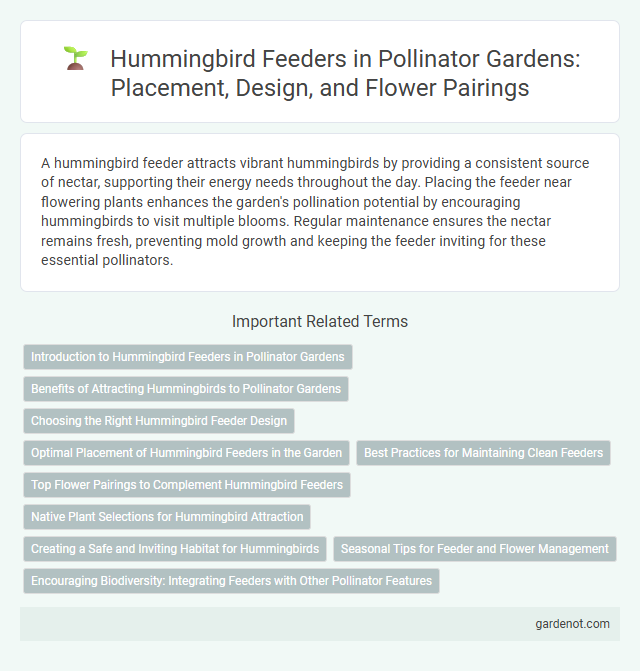A hummingbird feeder attracts vibrant hummingbirds by providing a consistent source of nectar, supporting their energy needs throughout the day. Placing the feeder near flowering plants enhances the garden's pollination potential by encouraging hummingbirds to visit multiple blooms. Regular maintenance ensures the nectar remains fresh, preventing mold growth and keeping the feeder inviting for these essential pollinators.
Introduction to Hummingbird Feeders in Pollinator Gardens
Hummingbird feeders provide a reliable source of nectar, attracting these vibrant pollinators to gardens year-round. Designed to mimic natural flowers, feeders help sustain hummingbird populations by offering an accessible energy supply essential for their high metabolism. Placing feeders strategically amidst native plants enhances pollination and fosters biodiversity within pollinator gardens.
Benefits of Attracting Hummingbirds to Pollinator Gardens
Hummingbird feeders enhance pollinator gardens by attracting these vibrant birds that contribute to effective pollination through their rapid movement between flowers. The presence of hummingbirds increases biodiversity and supports the growth of native plants by facilitating cross-pollination. Incorporating feeders also creates a visually dynamic environment that encourages ecological balance and garden vitality.
Choosing the Right Hummingbird Feeder Design
Selecting the right hummingbird feeder design is crucial for attracting and sustaining healthy pollinator activity in your garden. Opt for feeders with multiple feeding ports and built-in ant guards to prevent pests and facilitate easy access for hummingbirds. Clear or red-colored feeders without yellow components attract more hummingbirds while discouraging bees and wasps, enhancing pollination efficiency.
Optimal Placement of Hummingbird Feeders in the Garden
Optimal placement of hummingbird feeders in the pollinator garden enhances visibility and accessibility, increasing hummingbird visitation rates. Position feeders in shaded areas to prevent nectar spoilage while ensuring proximity to native flowering plants that provide natural food sources and shelter. Maintaining a distance of at least 10 feet between multiple feeders reduces territorial aggression among hummingbirds and promotes consistent feeding behavior.
Best Practices for Maintaining Clean Feeders
Regularly cleaning hummingbird feeders with a mixture of hot water and mild soap prevents mold and harmful bacteria growth, ensuring safe feeding. Rinse thoroughly to remove all soap residues and allow the feeder to air dry completely before refilling. Replace nectar every two to three days, or daily in hot weather, to maintain freshness and attract hummingbirds effectively.
Top Flower Pairings to Complement Hummingbird Feeders
Pairing hummingbird feeders with tubular, brightly colored flowers such as trumpet vine (Campsis radicans) and bee balm (Monarda didyma) enhances nectar availability and attraction. Salvias and columbines also serve as excellent companions, providing continuous bloom cycles that sustain hummingbird activity throughout the season. Strategic planting near feeders increases pollination efficiency and supports hummingbird habitat diversity.
Native Plant Selections for Hummingbird Attraction
Native plant selections such as bee balm (Monarda didyma), cardinal flower (Lobelia cardinalis), and red columbine (Aquilegia canadensis) provide vibrant, tubular blooms that effectively attract hummingbirds to pollinator gardens. These plants offer high nectar content that supports the energy needs of hummingbirds, enhancing the effectiveness of a hummingbird feeder when placed nearby. Incorporating native flowering plants alongside feeders creates a sustainable habitat that encourages natural feeding behaviors and promotes local biodiversity.
Creating a Safe and Inviting Habitat for Hummingbirds
A hummingbird feeder should be cleaned regularly with a mild solution of water and vinegar to prevent mold and harmful bacteria growth, ensuring a safe feeding environment. Using feeders with bright red accents attracts hummingbirds while providing multiple feeding ports reduces competition among birds. Placing feeders in shaded areas away from predators like cats and near flowering plants encourages hummingbirds to visit frequently, creating an inviting habitat.
Seasonal Tips for Feeder and Flower Management
To maximize hummingbird visits, clean feeders every week using hot, soapy water and avoid red dye in nectar to maintain natural feeding habits. Refill feeders with fresh nectar every 3-5 days, increasing frequency during hot summer months to prevent fermentation. Plant seasonally blooming flowers rich in tubular red, orange, and pink hues alongside the feeder to provide a continuous nectar source throughout spring, summer, and fall.
Encouraging Biodiversity: Integrating Feeders with Other Pollinator Features
Integrating hummingbird feeders with native flowering plants and butterfly houses creates a diverse ecosystem that supports multiple pollinator species. These feeders provide a consistent nectar source, attracting hummingbirds that enhance pollination of surrounding plants, boosting garden biodiversity. Combining feeders with varied pollinator habitats promotes ecological balance and sustains healthy pollinator populations year-round.
Hummingbird feeder Infographic

 gardenot.com
gardenot.com